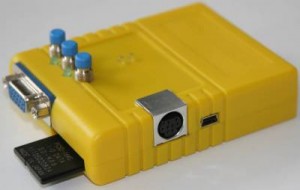 La cartuccia Chameleon Turbo 64 è estremamente facile da utilizzare dal momento che non serve aprire il proprio computer perche’ si collega alla porta di espansione del C64.
La cartuccia Chameleon Turbo 64 è estremamente facile da utilizzare dal momento che non serve aprire il proprio computer perche’ si collega alla porta di espansione del C64.
La cartuccia può funzionare anche come unità “stand-alone” questo perche’ al suo interno il cuore e’ un chip FPGA che emula quasi (ancora in beta) del tutto un Commodore 64, compreso il Floppy Drive e puo’ essere collegata ad un normale monitor VGA (LCD o CRT).
Changelog:
- New VGA controller with new modes and VIC-II sync.
- Tripple buffering mode added for properly displaying IFLI pictures.
- Scale-2x video scaling algorithm added.
- Scanline emulation added.
- In cartridge mode real CIAs registers and interrupts are used (allows use of a modem).
- In cartridge mode real VIC-II registers and interrupts are used (allows use of a lightpen).
- Fixed I/O assignments for FPGA (lower power use).
- Lowlevel SD-card functions now use multiple block reads if possible, which increases linear reading speed by about 40 to 50% (most noticeable on large files, such as REU images)
- BUGFIX: fixed error handling and timeouts of the IEC routines, which makes all related operations more robust.
- BUGFIX: added missing timeouts to SD-card functions.
- Joystick port 1 now also works for navigating the menus.
- BUGFIX: on some C64s pressing shift would result in phantom keypresses (F1/F2) under some conditions.
- NEW: various new VGA modes and other options for the new VGA controller (see manual)
- Improved loading speed of file inside T64 images.
- Improved keyboard handling to make the browser a bit snappier.
- BUGFIX: the size of the character ROM saved by the ROM saver was incorrect.
- BUGFIX: .wav player stops at the end of the file and does not continue playing garbage.
- BUGFIX: files bigger than 2k are displayed correctly by the .txt viewer.
- BUGFIX: when copying files out of a t64 image the resulting file was missing the last two bytes and/or the last block was missing completely.
- BUGFIX: filecopy from/to a IEC device did incorrectly abort after 1 block.
- BUGFIX: filecopy filename character set conversion was broken.
- BUGFIX: AR/RR ROM was not correctly disabled when autostarting programs from the filebrowser with AR/RR enabled as default cartridge.
- NEW: added DOS wedge command (see manual)
- NEW: added load and save commands (see manual)
Download: Chameleon 64 beta firmware 8b (1559)
source: beta.icomp.de
Micro SwinSID (SwinSID88) è un’ambizioso progetto di emulare l’integrato 6581/8580 della MOS Technology (SID) utilizzato nel Commodore 64 ma anche in altri progetti.
Aggiornamento Firmware (20120524):
- This version has only one improvement: fixed audio muting emulation.
Download: Nano/Micro SwinSID - Firmware update (20120524) (1978)
source: forum64.de
 La cartuccia Chameleon Turbo 64 è estremamente facile da utilizzare dal momento che non serve aprire il proprio computer perche’ si collega alla porta di espansione del C64.
La cartuccia Chameleon Turbo 64 è estremamente facile da utilizzare dal momento che non serve aprire il proprio computer perche’ si collega alla porta di espansione del C64.
La cartuccia può funzionare anche come unità “stand-alone” questo perche’ al suo interno il cuore e’ un chip FPGA che emula quasi (ancora in beta) del tutto un Commodore 64, compreso il Floppy Drive e puo’ essere collegata ad un normale monitor VGA (LCD o CRT).
Changelog:
- fixed REU, transfer length register is 1 after a transfer completes.
- fixed REU 512K wrap around.
- fixed cache controller preventing corruption when accessing 0x1FFFF0000 – 0x1FFFFFFFF
- faster SDRAM controller. More memory bandwidth for turbo.
- added slowdown modes to the Turbo settings. Offering CPU speeds of 25%, 50%, 75% and 100%.
- added native updater program (see manual) to update the fpga core without an usb connection.
- make menu item active when pressing a hotkey, so it is selected when going back to the respective menu.
- correctly mute/unmute second sid in menu freezer.
- clockport- and rr-net- items in options menu are correctly disabled if either is not available.
- if found, load and run update.prg from sd card (chameleon updater)
- if “boot from sd card” is enabled, load boot.prg from sd card (regular c64 boot program)
- improved navigation in one panel mode, cursor right enters subdir/image and cursor left goes one level up.
- improved quickfind, just type a filename quickly to jump to it.
- mount menu is skipped if there would only be one active item.
- when returning to the menu from the sid player by pressing left/menu button it will go directly to the filebrowser.
- added gfx viewer for various multi-color and hires formats.(see manual)
- added wav player (see manual)
- added filecopy (F5 in two panel mode, see manual)
- set $030c-$030e to 0 before starting prgs, increases compatibility with certain packers.
- .sid files which actually contain a basic program can now be run correctly.
- re-read destination panel after copying image.
Download: Chameleon Beta-7b release (1597)
source: beta.icomp.de
 Questi sono i risultati ufficiali dell’8bit computers multiscene party. Per maggiori informazioni e download visita la pagina ufficiale Forver 8bit party
Questi sono i risultati ufficiali dell’8bit computers multiscene party. Per maggiori informazioni e download visita la pagina ufficiale Forver 8bit party
Download:
source: forever.zeroteam.sk
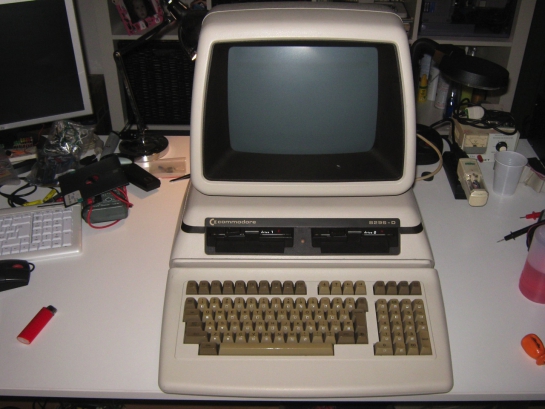
Autopsy:
testo tratto dalla homepage di ComputerMuseum.it:
I computer della serie “8000″ della Commodore si distinguono per la loro ineguagliata originalità formale: il design che caratterizza il Commodore 8296 è talmente particolare da renderlo inconfondibile. La base e il guscio che racchiude il monitor del Commodore 8296 sono plasmati secondo le scelte stilistiche operate dai designer: si può facilmente verificare che all’interno sono perlopiù vuoti, fatto che ne testimonia l’assoluta indipendenza dall’hardware che contengono.
Il Commodore 8296 deriva formalmente dai modelli “PET”, levigati e arrotondati fino a renderli praticamente privi di angoli. La tastiera dell’ 8296, che apparentemente costituisce un unico blocco con la base, è in realtà separabile: un cavo a spirale provvede a mantenere la connessione con l’unità centrale. Il monitor del Commodore 8296, che conserva l’impronta della forma trapezoidale del PET, può ruotare attorno alla base cilindrica per essere orientato secondo le esigenze dell’utente. Nei primi anni ’80 la Commodore deteneva l’80% del mercato informatico in Europa.
La serie “8000″, di cui fa parte il Commodore 8296, ebbe un notevole successo nell’area “educational” del mercato americano: la Commodore, infatti, regalava un computer ad ogni scuola che ne avesse acquistati almeno due. Benchè gli insegnanti preferissero i più costosi Apple e Tandy Radio Shack la scelta finì inevitabilmente sui computer di Jack Tramiel.
source: computermuseum.it
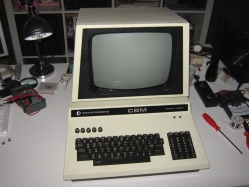
Autopsy:
testo tratto dalla homepage di Wikipedia:
Il Commodore PET, successivamente Commodore CBM, è stata una famiglia di personal computer a 8 bit della Commodore. Il primo modello commercializzato (primo personal computer della Commodore) è stato il PET 2001 risalente al 1977 e progettato da Chuck Peddle.
Si dice che PET (che in inglese significa piccolo animale domestico) sia l’acronimo di “Personal Electronic Transactor” (tutto-fare elettronico personale). Si trattava del primo computer di massa realizzato su di un blocco monolitico della storia (il primo computer all-in-one è stato lo Sphere 1 nel 1975). Nel case (involucro) erano infatti compresi l’unità centrale (CPU), la tastiera, il monitor ed anche l’unità a nastro (un registratore a cassette) come memoria di massa.
Il PET, basato sul processore MOS 6502 a 1 MHz, aveva 4 KB (PET 2001-4) o 8 KB (PET 2001-8) di RAM e 14 KB di ROM, con BASIC e sistema operativo installati su ROM.
Il PET 2001 presentava un elementare interprete BASIC, il Commodore BASIC (progettato dalla Microsoft ed acquistato dalla Commodore) che, unitamente al KERNAL (insieme di routine di I/O) e all’editor dello schermo, costituiva il sistema operativo della macchina. La modalità grafica disponibile era la sola modalità testo, visualizzazione monocromatica. Lo schermo era da 9″ in bianco e nero, o da 12″ a fosfori verdi o sempre bianco nero.
source: wikipedia
 La cartuccia Chameleon Turbo 64 è estremamente facile da utilizzare dal momento che non serve aprire il proprio computer perche’ si collega alla porta di espansione del C64.
La cartuccia Chameleon Turbo 64 è estremamente facile da utilizzare dal momento che non serve aprire il proprio computer perche’ si collega alla porta di espansione del C64.
La cartuccia può funzionare anche come unità “stand-alone” questo perche’ al suo interno il cuore e’ un chip FPGA che emula quasi (ancora in beta) del tutto un Commodore 64, compreso il Floppy Drive e puo’ essere collegata ad un normale monitor VGA (LCD o CRT).
Changelog:
Differences from Beta-6f to Beta-6g:
- Implemented bit-fade in SID when no waveform is selected.
- Implemented bit-fade in SID when reading write-only registers.
- Added bits to detect in menu when disk-images need update after write actions by the emulated drives.
- Implemented “door” on emulated drive, when open drive will read dummy bytes.
- Fixed CPU instruction timing bugs discovered when comparing emulated 6510 against real 6510.
- CPU irq/nmi timing fixes.
- Implemented bit-fade on I/O port of emulated 6510.
- Fixed SID stereo mapping for D500 and D700.
- Four timers added at addresses D0AA to D0AD for menu (it can’t use CIA timers when freezing).
Download: Firmware Chameleon Beta 6g (1431)
source: syntiac.com
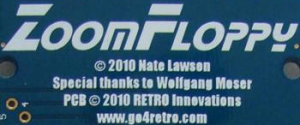 Il pacchetto ZoomFloppy v2.0 e’ il nuovo aggiornamento per l’interfaccia ZoomFloppy che include una nuova versione dell’OpenCBM e il firmware versione v0.7.
Il pacchetto ZoomFloppy v2.0 e’ il nuovo aggiornamento per l’interfaccia ZoomFloppy che include una nuova versione dell’OpenCBM e il firmware versione v0.7.
Here are the changes in the v2.0 version:
- Many improvements and bugfixes.
- Add support for IEEE-488 drives. Implemented by Thomas Winkler.
- Add experimental support for 1571 serial nibbling via the SRQ protocol. Now you don’t need a parallel cable with a 1571. Implemented by Arnd Menge.
- Add support for low-level drive analysis with a 1541 index-hole sensor. This works only on drives with a parallel port and nibtools.
- Bugfix: cbmcopy -r or cbmread now no longer hangs at the end of a transfer.
- Bugfix: don’t reset the bus twice if previous command was interrupted and this command is “cbmctrl reset”.
- Bugfix: increase reset time to 100 ms to be sure all drives are reset.
- Linux build fix for more modern kernels.
Download: OpenCBM (Win) + ZoomFloppy firmware v0.7 (1654)
Download: ZoomFloppy Manual v2.0 (1911)
source: google groups sourceforge.net tommy winkler homepage retro innovations
 La cartuccia Chameleon Turbo 64 è estremamente facile da utilizzare dal momento che non serve aprire il proprio computer perche’ si collega alla porta di espansione del C64.
La cartuccia Chameleon Turbo 64 è estremamente facile da utilizzare dal momento che non serve aprire il proprio computer perche’ si collega alla porta di espansione del C64.
La cartuccia può funzionare anche come unità “stand-alone” questo perche’ al suo interno il cuore e’ un chip FPGA che emula quasi (ancora in beta) del tutto un Commodore 64, compreso il Floppy Drive.
Tengo a precisare che la cartuccia puo’ essere collegata ad un normale monitor VGA (LCD o CRT).
Changelog:
Differences from Beta-6c to Beta-6d:
- Cartridge emulations.
- Turbo speed increase: Eliminated one clock cycle from critical path.
- Turbo speed increase: Writes to memory concurrent with next instruction fetch.
- Turbo speed increase: MMU caches last used CPU slot.
Download: Firmware Chameleon Beta 6d (1440)
source: syntiac.com
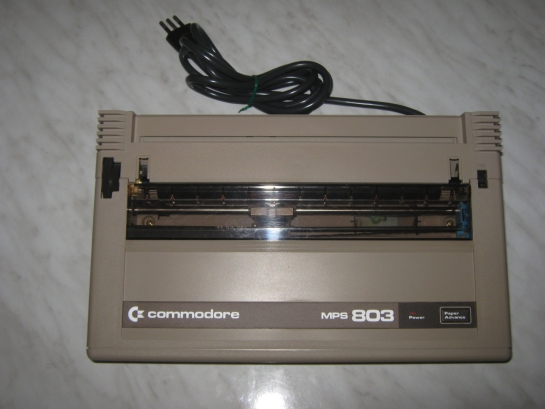
Autopsy:
La stampante Commodore MPS-803 e’ una stampante A4 a 80 colonne bidirezionale a matrice di punti con una velocità di 60 caratteri al secondo. Opzionale il trattore per le risme di carta a modulo continuo.
Download: Commodore MPS 803 Users Guide (3071)
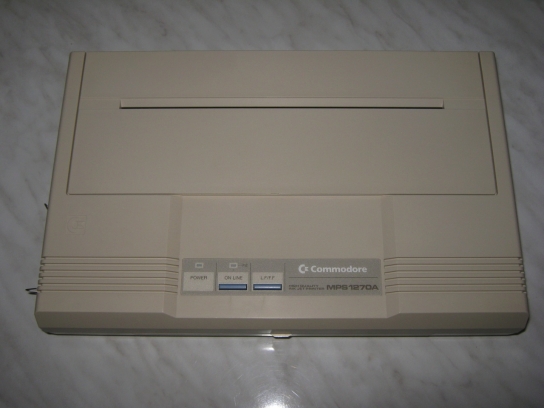
Autopsy:
La stampante MPS 1270 è stata la prima stampante a getto d’inchiostro della Commodore. La versione MPS 1270A (caratterizzata dalla lettera “A” dopo il 1270) aveva sia una porta Centronics (parallela) che la porta IEC Serial bus. Questo ha permesso di essere utilizzata dai computer Commodore (C64, C128, ecc) che con Amiga o PC.
Note:
- Le cartucce HP 51604A sono compatibili con questa stampante.
- Il connettore di alimentazione ha l’interno Negativo e l’esterno Positivo (9v 1A)
Download: Dip Switches MPS 1270 (2398)
 La cartuccia Chameleon Turbo 64 è estremamente facile da utilizzare dal momento che non serve aprire il proprio computer perche’ si collega alla porta di espansione del C64.
La cartuccia Chameleon Turbo 64 è estremamente facile da utilizzare dal momento che non serve aprire il proprio computer perche’ si collega alla porta di espansione del C64.
La cartuccia può funzionare anche come unità “stand-alone” questo perche’ al suo interno il cuore e’ un chip FPGA che emula quasi (ancora in beta) del tutto un Commodore 64, compreso il Floppy Drive.
Tengo a precisare che la cartuccia puo’ essere collegata ad un normale monitor VGA (LCD o CRT).
Changelog:
Differences from Beta-5b to Beta-6:
- Fixed RAM mirrors for 1541 drive emulation.
- Fixed reading from emulated SID.
- New cartridge emulations.
- Disk track lengths set to 6256, 6672, 7144 or 7696 bytes.
- Implemented disk-change with button.
- Input latch emulation in VIA emulation.
- Implemented SDR register in CIA.
- Implemented real IEC bus disable bit.
- VIC-II timing fixed for mode bits (MCM, BMM and ECM)
Differences from Beta-6 to Beta-6b:
- 1541 emulation: fixed IEC timing. All known speedloader problems are gone now.
- 1541 emulation: VIA6522 timer fixes.
- 1541 emulation: VIA6522 register r/w fixes.
- New cartridge emulations.
Differences from Beta-6b to Beta-6c:
- Auto speed option for turbo feature. Slows down on IEC bus accesses.
- PS/2 Page up/Page down alias for F1, F7. Easier navigation in the File-Browser.
Download: Turbo Chameleon 64 beta firmware v6c (1438)
source: syntiac.com
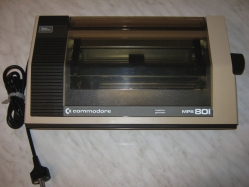
Autopsy:
Nota: Questa è stata la mia prima stampante.
La MPS 801 è una stampante ad aghi prodotta dalla Commodore. Per il collegamento viene utilizzata l’interfaccia seriale IEC ed è compatibile con VIC 20, C64, C128, C16, C116 e Plus/4. Il modello era disponibile nei colori beige e nero, evidentemente per adattarsi al colore dei vari modelli di computer ai quali poteva essere abbinata.
La stampante non è stata prodotta dalla Commodore. L’MPS-801 è stata prodotta dalla società giapponese Seikosha, una filiale del produttore di orologi Seiko. La stampante MPS-801 era identica alla Seikosha GP 500 VC.
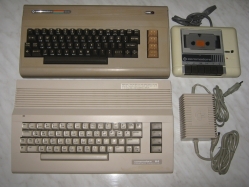
Si sono aggiunti due Commodore 64 alla mia Collezione.
Il case del Commodore 64 e’ stato conservato abbastanza bene, ma purtroppo qualcuno aveva avuto la malaugurata idea di attaccare dei piedini di feltro sul retro del Commodore 64, ovviamente dopo 20 anni la colla si era fusa con la plastica del case, ci ho messo un paio d’ore per togliere i residui di colla, ma ora i due Commodore 64 si presentano come nuovi.
 Grazie a Tommy Winkler il supporto del protocollo IEEE-488 per l’interfaccia ZoomFloppy fa’ ufficialmente parte della Distribuzione OpenCBM.
Grazie a Tommy Winkler il supporto del protocollo IEEE-488 per l’interfaccia ZoomFloppy fa’ ufficialmente parte della Distribuzione OpenCBM.
Potete trovare il codice sorgente aggiornato per l’interfaccia ZoomFloppy nel repository Opencbm GIT.
Software revision v0.6 for IEEE-488 support:
- Device detection for 3040, 4040, 8050, 8250, SFD-1001 (as 8250).
- CBMCTRL.
- CBMCOPY.
- D64COPY for 4040 (thanks to TNT) and 2031.
- D82COPY for 8050, 8250 and SFD-1001.
Firmware revision v0.07 for IEEE-488 support:
- 0.7 (2011/5/10) – Add IEEE-488 support (thanks to Tommy Winkler).
source: sourceforge.net tommy winkler homepage retro innovations
 La cartuccia Chameleon Turbo 64 è estremamente facile da utilizzare dal momento che non serve aprire il proprio computer perche’ si collega alla porta di espansione del C64.
La cartuccia Chameleon Turbo 64 è estremamente facile da utilizzare dal momento che non serve aprire il proprio computer perche’ si collega alla porta di espansione del C64.


































 Il pacchetto ZoomFloppy v2.0 e’ il nuovo aggiornamento per l’interfaccia ZoomFloppy che include una nuova versione dell’OpenCBM e il firmware versione v0.7.
Il pacchetto ZoomFloppy v2.0 e’ il nuovo aggiornamento per l’interfaccia ZoomFloppy che include una nuova versione dell’OpenCBM e il firmware versione v0.7.



















































Recent Comments